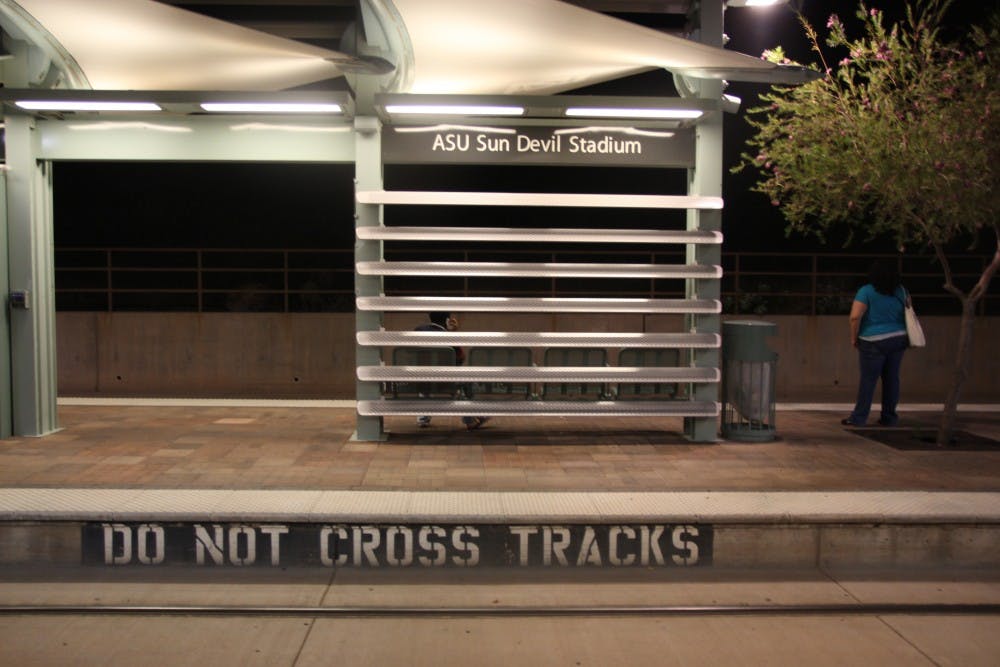Walk up to any Valley Metro Light Rail Station and you’ll see essentially the same image at every stop. Students, young professionals, families and a few questionable characters waiting anxiously for the next train.
Most have purchased a ticket for the day or scanned their U-Pass at the kiosks towards the ends of the station, but a few take their chances and decide to skip on paying the $2 fare. Security officers on the trains pop up occasionally, making their rounds, but they usually stay on board for only one or two stops.
Look a little closer, you’ll see many of the students waiting are clutching onto a lanyard decorated with keys, school ID’s and pepper spray. Headphones are immediately put on and awkward eye contact is exchanged. It’s clear many passengers often feel uncomfortable on the platforms and on the train itself. Especially at night, when the ratio of students to complete strangers increases dramatically.
As far as reported crime goes, the light rail provides a fairly safe environment for its riders. According to Valley Metro, only six thefts, 18 assaults, five robberies and zero sexual assaults were reported per year.
However, these numbers do not account for the times students have felt uncomfortable or even threatened on the light rail. Often, police reports will not be filed and stories about unfortunate incidents are only reported to friends and family. Some students may also be unaware of the systems ASU and Valley Metro have in place in order to keep students safe on the light rail.
What the Students Say
Exercise and wellness senior Lisa Williams found herself in an extremely uncomfortable situation while she traveled from Tempe to downtown Phoenix. At around 4 p.m. a man who had recently urinated himself boarded the train and took a seat next to Williams.
“Probably two minutes after he sat down he just started yelling at me,” Williams says. “And he was asking me where this place was and I had no clue what he was saying. (I had) no clue what he was talking about.”
Finally, a passenger from across the train told the man to stop. However, the man continued to sit next to Williams until he disembarked a few stops later.
After the incident, Williams says she avoids the light rail as much as possible. She lives downtown now so she no longer needs to take the train in between the two cities as frequently.
“I think that was my last time that I took it all the way..I’ve had to take it a couple other times but not that whole duration anymore,” Williams says. “I’ve probably taken it once this year (the entire way from Tempe to downtown Phoneix).”
Unfortunately for Williams, Valley Metro security did not board the train during her incident. She says she did not go to security because there was no one near her at the time everything happened. But, luckily, there are cameras.
“I think it would be a good idea to have someone (security) stationed in each train,” Williams says.
Although Williams’ story is troubling, not all students have felt uncomfortable or unsafe on the light rail.
Journalism sophomore Shania Alba took the light rail four to five times a week last year to get to work, sometimes late at night, and never faced something unsettling while on the train or platform.
“I used public transportation back home in California..so I was kind of used to people that are very uncomfortable and off-putting," Alba says. “I have some strange experiences, but nothing to make me feel like I need to call the police or like my safety was thoroughly in jeopardy.”
In order to protect herself, Alba says she has a “system” for when she rides the light rail. She sits at a window seat, puts on headphones and keeps her face as stoic as possible so others know she doesn’t want to be approached.
Although Alba has stayed safe while on the light rail platform and on the train itself, she says she has been followed after she got off.
What the Officials Say
According to ASU’s Parking and Transportation Services (PTS), 4,978 students have purchased a U-Pass for the 2015-2016 school year. However, if any of those students wish to file a complaint about the light rail they may jump through a few hoops to do so.
“While ASU PTS regularly works with Valley Metro, PTS does not have any authority to alter or influence their operations. As always, PTS advocates for a system that supports student's needs and better serves the Sun Devil community,” said a spokesperson PTS via email. “Students, faculty and staff are welcome to send comments to PTS about Valley Metro operations, and should also attend public meetings of and provide comments directly to Valley Metro to influence change through the democratic process.”
Besides filing a complaint, safety tips could also help prevent an unsettling event from taking place. Nicole Franks, ASU Police media relations specialist, recommends students move to a seat near the doors or conductor if they feel threatened. Contradictory to what Alba does, she also suggests students refrain from listening to music or texting on the light rail.
“Student safety is always a top priority for the ASU Police Department whether students are on the light rail or elsewhere in the Phoenix metropolitan area,” Franks says in an email. “We understand our students use public transportation to get to and from our campuses, which is why we brief students during orientation and throughout the year to be vigilant and aware of their surroundings.”
Downloading the ASU LiveSafe mobile app is also encouraged. The app lets friends and family virtually walk someone home and users can alert them if a dangerous situation occurs. Additionally, LiveSafe provides a direct link to emergency services. Students can live chat with ASUPD and send pictures, audio and video if necessary.
According to Ann Glaser, a spokeswoman for Valley Metro, the light rail was meant to be a “community asset” and designed like many other rail systems on the west coast which is why Valley Metro light rail does not require passes to be scanned immediately after boarding.
Instead, the rail relies on security officials, a partnership with Phoenix, Tempe and Mesa police departments, emergency call buttons, and hundreds of surveillance cameras to keep things in check.
“Safety is a responsibility we all share,” Glaser says.




